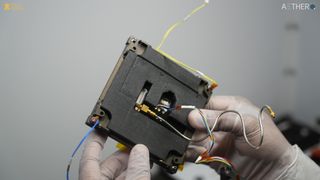SpaceX to launch 1st space-hardened Nvidia AI GPU on upcoming rideshare mission
"This is going to be the fastest AI computer ever launched to space."

AI is about to take a major leap to conquer the final frontier. An Nvidia Jetson Orin NX chip, one of the most popular AI and edge computing GPUs, will travel to space soon on SpaceX's Transporter 11 mission.
While AI has taken the world by storm in recent years, the technology's deployment in orbit has been slow. Outside of Earth's atmosphere, ionized particles and cosmic rays hammer satellites, threatening their electronics. For computers to survive in space, they must be hardened — made of resilient materials and designed to withstand high doses of radiation. But to make a computer fit for space takes years. Satellite manufacturers therefore often have to make do with rather obsolete processors.
Georgia-based Cosmic Shielding Corporation (CSC), a spin-out from Sweden's Chalmers University of Technology, thinks it has a solution to the problem. The company has developed a special nanocomposite shielding metamaterial — a kind of polymer interspersed with nanoparticles (the exact composition of which is a trade secret) — that stops the charged particles in their tracks.
CSC has previously tested the lightweight material in particle accelerators on Earth and during an eight-month experiment at the International Space Station. However, Transporter 11 — a SpaceX rideshare mission that could launch as early as this Friday (Aug. 16) — will mark the first time that the shielding protects a real AI computer on a space mission.
Related: Artificial intelligence could help hunt for life on Mars and other alien worlds
"This is going to be the fastest AI computer ever launched to space," Yanni Barghouty, CSC's cofounder and CEO, told Space.com. "The goal of this mission is simply to demonstrate the successful operation of an AI-capable Nvidia GPU on orbit with minimal to no errors while operating."
The GPU will fly aboard a cubesat built by San Francisco-based company Aethero, a maker of high-performance, space-rated computers. The GPU's only task during its four-month orbital mission will be to make mathematical calculations, the results of which will be beamed to Earth and carefully checked.
Get the Space.com Newsletter
Breaking space news, the latest updates on rocket launches, skywatching events and more!
"One of the main effects of space radiation are errors," Barghouty said. "AI-capable GPUs are particularly vulnerable to that because they have many transistors that run calculations in parallel. If one transistor gets affected, it often affects a bunch of others."
A successful completion of the test, Barghouty hopes, will launch the satellite industry into the age of AI for real. CSC already sees a lot of demand for its shielding from established satellite manufacturers and Earth-observation providers hoping to be able to analyze and process images directly on board satellites. AI's arrival in space is hotly anticipated, as it will enable a whole range of new kinds of missions that require advanced image analysis and visual navigation — in-orbit servicing and manufacturing, for example, as well as active space debris removal and space debris avoidance.
"Every single one of these companies is interested in using the most modern AI-capable hardware," said Barghouty. "On Earth, AI is having a massive effect on efficiency of electronic systems, and the space industry wants to tap into that. For years, Moore's law only applied on Earth. But with our technology, it will also apply in orbit."
(Moore's law refers to the observation by American engineer Gordon Moore that the computing power of integrated circuits doubles about every two years).
The shielding will also make computers last longer in space, increasing the lifetime of missions and saving cost. The same material could also be used in spacesuits and as radiation protection for future space stations and moon habitats, said Barghouty.
"As a company, we are working on several areas across the board," said Barghouty. "A success here will open the door for the other applications as well."
Join our Space Forums to keep talking space on the latest missions, night sky and more! And if you have a news tip, correction or comment, let us know at: community@space.com.

Tereza is a London-based science and technology journalist, aspiring fiction writer and amateur gymnast. Originally from Prague, the Czech Republic, she spent the first seven years of her career working as a reporter, script-writer and presenter for various TV programmes of the Czech Public Service Television. She later took a career break to pursue further education and added a Master's in Science from the International Space University, France, to her Bachelor's in Journalism and Master's in Cultural Anthropology from Prague's Charles University. She worked as a reporter at the Engineering and Technology magazine, freelanced for a range of publications including Live Science, Space.com, Professional Engineering, Via Satellite and Space News and served as a maternity cover science editor at the European Space Agency.